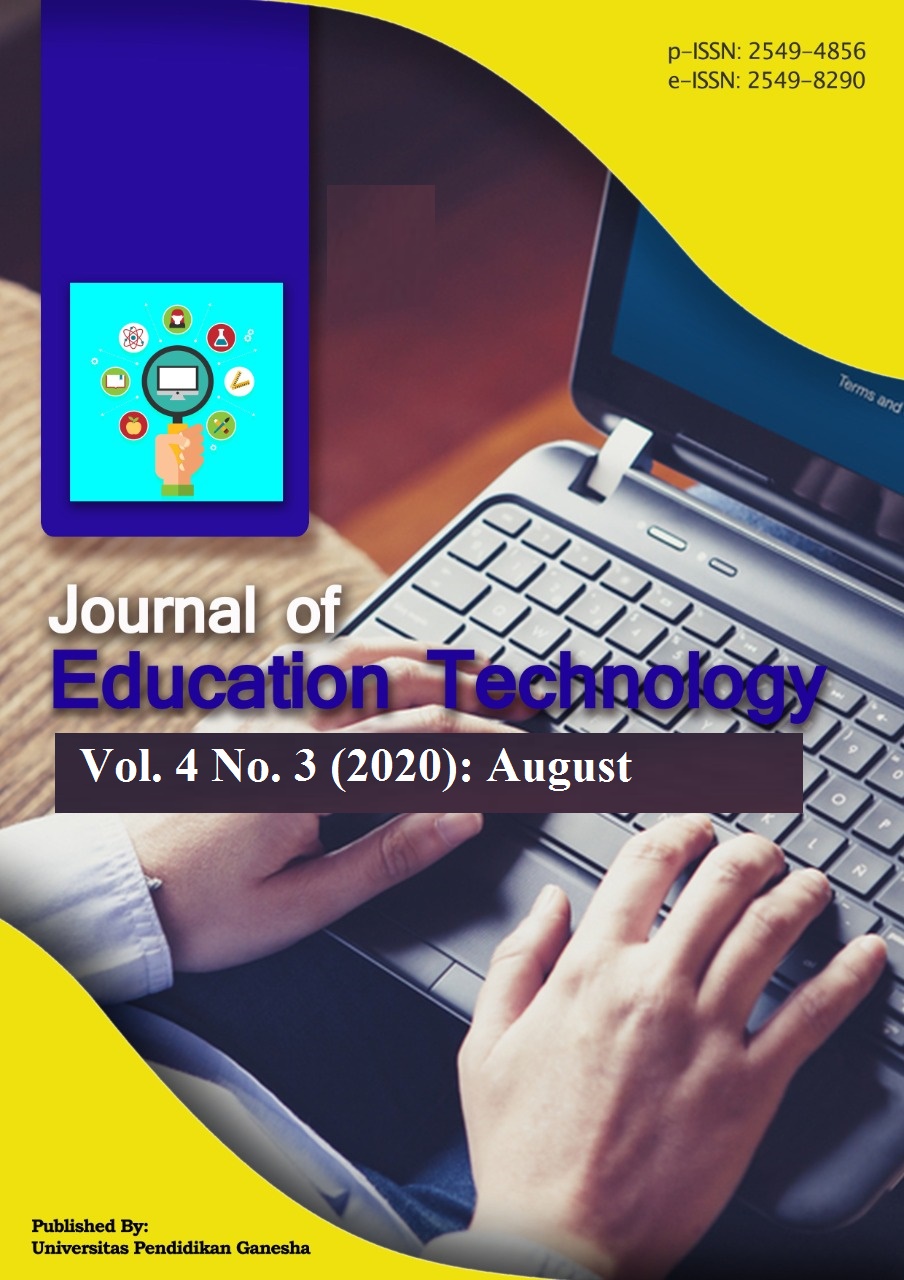The Use of Audio-Visual Assisted Google Classroom for Mathematics Course
DOI:
https://doi.org/10.23887/jet.v4i3.28529Kata Kunci:
audio visual, google classroom, mathematicsAbstrak
The use of technology in the form of mathematics learning media has not been maximally applied amidst the rapid advances in technology today, coupled with a change in learning patterns from face-to-face in class to online learning patterns due to calls to work from home. This of course will have an impact on the learning outcomes of students. Seeing these conditions, innovation is needed in mathematics learning, namely by utilizing the use of media in learning, one of which is the use of audio-visual media assisted by google classroom. The purpose of this research is to determine the effect of using audio-visual media assisted by google classroom on mathematics courses at STMIK STIKOM Indonesia. The research method used was a quasi-experimental with a non-equivalent control group design. The instrument used in this study was a mathematics learning outcome test. The data analysis technique in this research includes descriptive analysis. The results showed that there was an effect of the use of audio-visual media on mathematics learning outcomes with an average score of 76.00 mathematics learning outcomes which was declared significant so that learning using audio-visual media had an effect on mathematics learning outcomes.
Referensi
Anggraeni, R., Andriani, S., & Ad, Y. (2019). Effect of Thinking Aloud Pair Problem Solving ( TAPPS ) Method with Audio Visual Media for Students ’ Critical Thinking Ability. 2(1), 31–33.
Ansong-Gyimah, K. (2020). Students' perceptions and continuous intention to use e-learning systems: The case of google classroom. International Journal of Emerging Technologies in Learning, 15(11), 236–244. https://doi.org/10.3991/IJET.V15I11.12683
Ayu, K., Kawi, Y., Suadnyana, I. N., & Suryamanuaba, I. B. (2019). Pengaruh Model Pembelajaran Auditory , Intellectualy , Repetition Berbantuan Media Audio Visual terhadap Kompetensi Pengetahuan IPA. 3(1), 70–78.
Diana, L., & Maharani, A. (2019). Pengembangan Media Pembelajaran Audio Visual Dengan Teknik Tutorial Berbasis Kemampuan Konseptual Pada Mata Pelajaran Integral. Jurnal Derivat: Jurnal Matematika Dan Pendidikan Matematika, 6(1), 25–31.
Ernawati, E. (2014). Pemanfaatan Media Pembelajaran Audio Visual Untuk Meningkatkan Hasil Belajar PAI Pada Siswa Kelas V SDN Kalianget Timur X. PEDAGOGIA: Jurnal Pendidikan, 3(2), 81. https://doi.org/10.21070/pedagogia.v3i2.59
Fadillah, A., & Bilda, W. (2019). Pengembangan Video Pembelajaran Matematika Berbatuan Aplikasi Sparkoll Videoscribe. 2, 177–182.
Febryanto, F. N. (2015). Pembelajaran Lay Up Shoot Menggunakan Media Audio Visual Basic Lay Up Shoot Untuk Meningkatkan Hasil Belajar Lay Up Shoot Pada Siswa Kelas Viiia Smp Kanisius Pati Tahun 2013/2014. E-Jurnal Physical Education, Sport, Health and Recreation, 4(1), 1509–1521. https://doi.org/10.15294/active.v4i1.4548
Hikmah, N. (2017). Pengembangan Multimedia (Audiovisual) Pembelajaran Matematika Pada Materi Bangun Ruang Bagi Siswa Kelas IV SD. Jurnal Pendas Mahakam, 2(1), 83–90.
Kania, N., & Arifin, Z. (2020). Aplikasi Macromedia flash untuk Meningkatkan Pemahaman Konsep Matematika Siswa. 4(1), 96–109.
Kusuma, I. D. M. A. W. (2018). Upaya Meningkatkan Hasil Belajar Dribble Sepak Bola Melalui Model Pembelajaran Numbered Head Together ( Nht ) Dan Media Audio Visual. Jurnal SPORTIF: Jurnal Penelitian Pembelajaran, 4(1), 73–86.
Maharani, N., & Kartini, K. S. (2019). Penggunaan google classroom sebagai pengembangan kelas virtual dalam keterampilan pemecahan masalah topik kinematika pada mahasiswa jurusan sistem komputer. PENDIPA Journal of Science Education, 3(3), 167–173. https://doi.org/10.33369/pendipa.3.3.167-173
Marhayanti, A. (2018). Memproduksi Teks Prosedur Kompleks Menggunakan Media Audio Visual Pada Siswa Sma. Jurnal Edukasi Khatulistiwa, 1(1), 9. https://doi.org/10.26418/ekha.v1i1.24830
Nirfayanti, & Nurbaeti. (2019). Pengaruh Media Pembelajaran Google Classroom Dalam Pembelajaran Analisis Real Terhadap Motivasi Belajar Mahasiswa. Proximal, 2(1), 50–59.
Nomleni, F. T., & Manu, T. S. N. (2018). Pengembangan Media Audio Visual dan Alat Peraga dalam Meningkatkan Pemahaman Konsep dan Pemecahan Masalah. Scholaria: Jurnal Pendidikan Dan Kebudayaan, 8(3), 219–230. https://doi.org/10.24246/j.js.2018.v8.i3.p219-230
Nosa, D. E. (2018). Aplikasi Wingeom dan Camtasia Studio untuk Pembuatan Media Pembelajaran Audio Visual. Desimal: Jurnal Matematika, 1(2), 127–137.
Nurcahyono, N. A., & Novarina, E. (2016). International Seminar on Education “ Education Trends for Future Society ” Developing Audio Visual CD Material For Basic Teaching International Seminar on Education “ Education Trends for Future Society .” 195–201.
Pranowo, T. A., & Prihastanti, A. (2020). Pengaruh Bimbingan Kelompok Melalui Media Audio Visual Terhadap Motivasi Belajar Siswa. Indonesian Journal of Learning Education and Counseling, 2(2), 217–223. https://doi.org/10.31960/ijolec.v2i2.338
Sari, D. P., Sukmawati, R. A., Purba, H. S., Maulana, D., & Azis, H. (2019). Pelatihan Penggunaan Google Classroom untuk Mengoptimalkan Proses Pembelajaran. 1(2), 56–60.
Sarwinda, K., Rohaeti, E., & Fatharani, M. (2020). The development of audio-visual media with a contextual teaching-learning approach to improve learning motivation and critical thinking skills. 2(2), 98–114.
Wahyudi, A., Suhartono, & Ngatman. (2003). Penggunaan Media Audio Visual. Jurnal Penelitian Pendidikan, 1–19.
Yuanta, F. (2017). Pengembangan Media Audio Visual Mata Pelajaran Bahasa Indonesia Untuk Sekolah Dasar. Ibriez : Jurnal Kependidikan Dasar Islam Berbasis Sains, 2(2), 59–70. https://doi.org/10.21154/ibriez.v2i2.36
Yusantika, F. D., Suyitno, I., & Furaidah. (2018). Pengaruh Media Audio dan Audio Visual terhadap Kemampuan Menyimak Siswa Kelas IV. Jurnal Pendidikan, 3(2), 251–258. http://journal.um.ac.id/index.php/jptpp/ EISSN: 2502-471X DOAJ-SHERPA/RoMEO-Google Scholar-IPI%0AJurnal.
Unduhan
Diterbitkan
Cara Mengutip
Terbitan
Bagian
Lisensi
Authors who publish with the Journal of Education Technology agree to the following terms:
- Authors retain copyright and grant the journal the right of first publication with the work simultaneously licensed under a Creative Commons Attribution License (CC BY-SA 4.0) that allows others to share the work with an acknowledgment of the work's authorship and initial publication in this journal.
- Authors are able to enter into separate, additional contractual arrangements for the non-exclusive distribution of the journal's published version of the work (e.g., post it to an institutional repository or publish it in a book), with an acknowledgment of its initial publication in this journal.
- Authors are permitted and encouraged to post their work online (e.g., in institutional repositories or on their website) prior to and during the submission process, as it can lead to productive exchanges, as well as earlier and greater citation of published work. (See The Effect of Open Access)
















